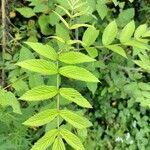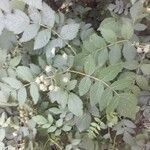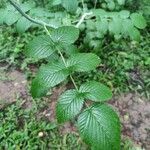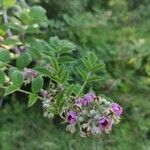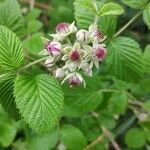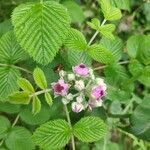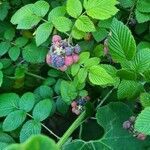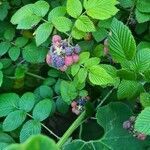Usually erect, sometimes climbing shrubs, up to 2 m high, the often drooping branches up to 3.5 m long. Stems sparsely hairy, glabrescent, prickles usually rather few, straight to curved, up to 7 mm. Leaves imparipinnate, up to 27 cm long, petiole 1.5-5 cm long. Stipules (linear-)lanceolate, 6-16 by 1-3(-5) mm, slightly hairy to glabrous. Leaflets 2-4(-5) opposite pairs, elliptic or rhombic to ovate, sometimes ovate-lanceolate, 2-8 by 1-4 cm, base usually acute, margin serrate to biserrate but the basal part often entire, apex acute to acuminate, papyraceous to pergamentaceous, 6-9 pairs of nerves, soft-hairy above but soon glabrate, lower surface with a woolly silvery-white felt of short curly hairs all over and with longer straight hairs on main nerves. Inflorescence usually rich and branched, a compound leafy thyrse up to 20 cm long. Bracts stipule-like. Pedicels up to 1.5 cm, hairy. Hypanthium 2-3 mm across, hairy outside. Sepals triangular, 4-7 by 1.5-2.5 mm including the up to 2 mm long acumen, densely woolly outside, acumen mostly glabrous. Petals falling rather early, suborbicular, 3.5-5 by 3-3.5 mm, 1 mm clawed, pink. Stamens 25-35, filaments up to 4 mm, anthers c. 0.5 mm long. Pistils 50-75 or more, ovaries rather densely long-hairy, on elevated, hairy torus with pistils down to the base, style up to 3 mm long. Collective fruits globular to broadly ovoid, up to c. 1 cm across, compact, sepals spreading. Fruits c. 2.5 mm long, exocarp densely hairy, red but the colour masked by the dark (blue to blackish) hair-cover, mesocarp only a thin layer when dry.
Shrubs, 10–30 dm, armed. Stems ?biennial?, erect to arching, often scrambling, sparsely hairy, glabrescent, eglandular, strongly pruinose; prickles sparsely to moderately dense, hooked to reflexed, stout, 3–9 mm, broad-based. Leaves deciduous, pinnately compound; stipules linear-lanceolate, 4–8 mm; leaflets (3–)5–7(–9), terminal ovate to broadly ovate, 4–6.7 × (2.4–)3.4–5.4 cm, base shallowly cordate, sometimes shallowly 3-lobed, margins coarsely serrate to doubly serrate, apex acute to short-acuminate, abaxial surfaces with scattered, reflexed, broad-based prickles on midveins, densely white-tomentose, eglandular. Inflorescences terminal and axillary, 1–11-flowered, cymiform. Pedicels: prickles absent or sparse, erect to reflexed, pubescent, eglandular. Flowers bisexual; petals pink to magenta, broadly obovate to orbiculate, 4 mm; filaments laminar; ovaries densely hairy. Fruits purple-black, hemispheric to globose, 0.5–1.5 cm; drupelets 50–75, coherent, separating from torus. 2n = 14.
Perennial shrub, up to 2 m high; stems dense, intertwined, eglandular, glabrous. Leaves 3-5-partite on floricanes, mostly 7-partite on primocanes; elliptic to ovate-acute, terminal one broader than laterals, somewhat cordate at base, cuspidate at apex, margins shallowly singly or doubly serrate; upper surface thinly hairy, nerves furrowed, lower surface armed with small recurved prickles. Stipules lanceolate. Inflorescence terminal and axillary, often few-flowered; peduncles and pedicels pale greyish tomentose. Flowers: calyx deeply divided into narrowly ovate, shortly acuminate lobes; petals shorter than sepals, claw narrow, limb subcircular, caducous. Flowering time Jan.-Apr.
An erect, bushy shrub.. Stems glabrescent.. Leaves imparipinnate (2–3-jugate); leaflets green and thinly hairy above, whitish-grey-tomentose beneath; the terminal leaflets broadly ovate, basally cordate, larger than the elliptic or ± ovate-elliptic lateral leaflets.. Inflorescence short, ± corymbose, leafy and usually overtopped by leaves.. Calyx lobes ± 5 mm. long, exceeding the petals, densely pilose.. Carpels densely tomentose.
Leaflets elliptic to ovate-acute, the terminal one broader than the laterals and often somewhat cordate at the base and cuspidate at the apex; margins shallowly singly or doubly serrate, the veins excurrent; superior surface dark greyish-green, glabrous; inferior surface white-felted, with prominent veins, the midrib not prickly; leaflets somewhat plicate along the lines of lateral veins.
A very spiny scrambling shrub. It grows 1-2.5 m tall. Branches are purple or green. The leaves have 5 to 9 leaflets along the leaf stalk. The edges are toothed and the lower surface is whitish. The fruit occur in clusters near the ends of branches. They change from dark red to black at maturity. They are 0.8-1.2 cm across. They have a good flavour.
Flowering branches glabrous except in the inflorescence, white-pruinose at first, becoming glossy and dark reddish or purplish; prickles 4–7 mm. long, straight to weakly decurved, at first pruinose and then glossy like the stems.
Shrub or scrambler. Leaves discolorous, venation on both leaf surfaces prominent, lateral leaflets ovate, 30-35 x 16-19 mm. Corolla shorter than calyx. Fruits hairy. Flowers purplish pink.
Leaves 10–17 x 4–8 cm., 2–3-jugate; petiole and rhachis tomentose, glabrescent, bearing hooked prickles; lateral leaflets subsessile, the terminal one with petiolule 1·5–2 cm. long.
Inflorescences terminal and axillary, shorter than the leaves, often few-flowered; peduncles and pedicels pale greyish-tomentose, longer than bracts and bracteoles.
Petals shorter than sepals, white to mauvish-pink or red, with broad subcircular limb and narrow claw, caducous.
Fruit 5–7 mm. long, 8–10 mm. broad, cordate in longitudinal section, purplish when ripe; carpels pubescent.
Calyx whitish-tomentose, deeply divided into narrowly ovate, shortly acuminate lobes 4–5 mm. long.
Shrub to c. 2 m. high.
Stipules lanceolate.
